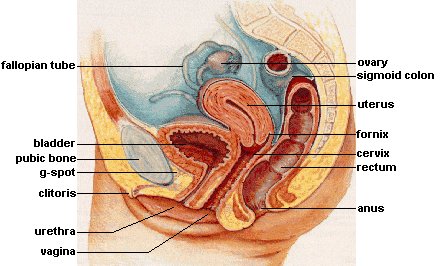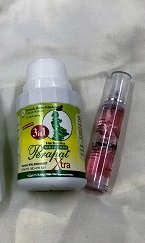Internal Vaginal Anatomy
Here are the components of the internal vaginal anatomy and their functions:-
Vagina
Nestled within the folds of the labia is the vagina. It is a tube-like, muscular but elastic organ which is about 3/4 inch wide and extends from the vaginal opening to the cervix which is a length of 4 to 5 inches inwards in an adult woman.
The vagina is the organ for sexual intercourse in women whereby the erect penis is inserted into it. It is the passageway for sperm to travel to the egg and menstrual bleeding or a baby to come out.
As it is make up of highly elastic tissues it can stretch and expand to many times its original size. Thereby making it possible for a baby to pass through during labor or comfortably accommodate a penis of any size during sexual excitement.
The first inch of the vagina is the most erogenous and pleasure-receptive as this is where most of the nerve endings are situated.
The lower part of the vagina is surrounded by elastic muscles that control the diameter of its opening. And it is these muscles that contract rhythmically and involuntarily during orgasm.
The vagina will contract back to its original state shortly after intercourse. As for vaginal delivery it will return to its original condition (almost) in about 2 months.
Diagram of Internal Vaginal Anatomy
 Diagram of the various parts of the internal vaginal anatomy
Diagram of the various parts of the internal vaginal anatomyThere are two key players in the internal vaginal anatomy, (inside the vagina to be precise), that help make sexual intercourse easier and more pleasurable for both partners. They are the:-
1. Rugae – these are ridges or folds and furrows that line the vaginal wall. They look much like the ridges you see in corrugated cardboard. The rugae help to grip the penis and draw it deeper inside the vagina. This gripping with its warm, slippery sensation is what drives a guy crazy! It makes him feel really contained, totally surrounded by your soft flesh.
2. Bartholin’s Glands - These are glands that line both sides of the vaginal opening. They secrete small amounts of lubricating fluid to keep the inner lips moist during sexual arousal. Further in are the hymen glands which produce lubrication to keep the vaginal canal moist.
G-Spot
There is still debate about the existence of this component of the internal vaginal anatomy. But for myself and other women who have experienced its ecstasy, it is a powerhouse of sexual stimulation. The G-spot is also linked to the phenomenon of female ejaculation (the reason for the wet spot on your bed). When ejaculation occurs it is a very electrifying experience.
What about you, have you ever experienced female ejaculation? Do share so that other women would know what it is like.
Want to know how to find and awaken your G-spot? Find out from my menopause vaginal dryness page.
Cervix
Situated at the top of the vagina, the cervix is make up of smooth muscles and collagen fibers and acts as a gateway to the uterus. It varies in diameter from 1 to 3cm, depending upon the time in the menstrual cycle the measurement is taken. The cervix is plugged with cervical mucus to protect it against infection. During ovulation this mucus changes into a thin fluid to ease the passage of sperm.
Uterus
The uterus or womb is the main female reproductive organ in the internal vaginal anatomy. The inner wall of the uterus (endometrium) is lined with a layer of cells, which responds to hormonal stimulation.
During ovulation, this stimulation causes the endometrium to grow and thicken in preparation for the fertilized egg. If fertilization does not happen this layer is shed as menstrual blood. Should pregnancy occurs, this lining becomes the spongy nest for the implantation of the fertilized egg, where the baby grows and develops.
The uterus is lined with powerful muscles to push the child out during labor.
Ovaries
Attached to the uterus via strong but thin ligaments are the ovaries. The ovaries are the main producers of vaginal estrogen - the female sex hormone. At birth the ovaries contain over 400,000 egg follicles and this is all a woman will have in her lifetime. However, this is more than enough since most women will go through an average of 500 menstrual cycles.
Each month, a matured egg (ova) travels down the fallopian tube, a journey of about 3 to 4 days. This is the time where a woman is most fertile and pregnancy will probably occur. Eggs that are not fertilized are expelled during menstruation or natural vaginal bleeding.
With all the structures and functions of the internal and external vaginal anatomy covered, I am sure you will be able to enjoy better vaginal health. Best of all you will have a a more gratifying sex life as now you know where all the erogenous zones of the vagina are.
Back to top- Home
- Anatomy of the Vaginal Area
- Internal Vaginal Anatomy


Facebook Comments
Thanks for visiting. Have your say on what you just read? Leave a comment in the box below!